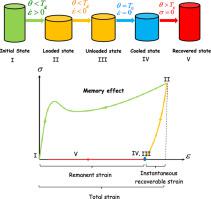当前位置:
X-MOL 学术
›
Mech. Mater.
›
论文详情
Our official English website, www.x-mol.net, welcomes your feedback! (Note: you will need to create a separate account there.)
Plasticity and thermally-induced recovery in polycarbonate
Mechanics of Materials ( IF 3.9 ) Pub Date : 2020-09-01 , DOI: 10.1016/j.mechmat.2020.103515 Mohammed Nadhir D. Cherief , Fahmi Zaïri , Ning Ding , Jean-Michel Gloaguen , Moussa Naït-Abdelaziz , Mohamed Benguediab
Mechanics of Materials ( IF 3.9 ) Pub Date : 2020-09-01 , DOI: 10.1016/j.mechmat.2020.103515 Mohammed Nadhir D. Cherief , Fahmi Zaïri , Ning Ding , Jean-Michel Gloaguen , Moussa Naït-Abdelaziz , Mohamed Benguediab

|
Abstract In the present paper, we present an approach combining physically-based constitutive modeling and experiments to study the thermo-mechanical response of amorphous thermoplastics whose final objective is the prediction of the thermally-induced strain recovery. The underlying thermo-mechanical mechanisms are described by elastoviscoplastic-viscohyperelastic constitutive relations allowing to account for the variation with temperature of the inter and intramolecular barriers to deformation and their abrupt change when the temperature traverses the glass transition. The model fit shows a good agreement with experimental observations on polycarbonate in terms of temperature and strain-rate dependent stress-strain response. The material kinetics with temperature is designed and introduced into the model to predict the thermally-activated strain recovery process during heating. In our approach, the intramolecular resistance of the entangled molecular chain network orientation/relaxation is used as the driving stress that continuously activates the strain recovery process during zero-stress creep above glass transition. The model predictions are shown under zero-stress creep recovery for different previous loading histories in terms of strain-rate and strain-level. The simulated results are in satisfactory agreement with experimental observations at different heating temperatures showing the relevance of the proposed approach.
中文翻译:

聚碳酸酯的塑性和热致恢复
摘要 在本文中,我们提出了一种结合基于物理的本构建模和实验的方法来研究无定形热塑性塑料的热机械响应,其最终目标是预测热致应变恢复。潜在的热机械机制由弹粘塑性 - 粘超弹性本构关系描述,允许解释分子间和分子内变形障碍随温度的变化以及当温度穿过玻璃化转变时它们的突然变化。在温度和应变速率相关的应力应变响应方面,模型拟合与聚碳酸酯的实验观察结果非常吻合。设计了随温度变化的材料动力学并将其引入模型以预测加热过程中的热激活应变恢复过程。在我们的方法中,缠结的分子链网络取向/松弛的分子内阻力用作驱动应力,在玻璃化转变以上的零应力蠕变期间连续激活应变恢复过程。模型预测显示在零应力蠕变恢复下针对不同的先前加载历史的应变率和应变水平。模拟结果与在不同加热温度下的实验观察结果令人满意地一致,表明所提出的方法的相关性。缠结的分子链网络取向/松弛的分子内阻力用作驱动应力,在玻璃化转变以上的零应力蠕变期间连续激活应变恢复过程。模型预测显示在零应力蠕变恢复下针对不同的先前加载历史的应变率和应变水平。模拟结果与在不同加热温度下的实验观察结果令人满意地一致,表明所提出的方法的相关性。缠结的分子链网络取向/松弛的分子内阻力用作驱动应力,在玻璃化转变以上的零应力蠕变期间连续激活应变恢复过程。模型预测显示在零应力蠕变恢复下针对不同的先前加载历史的应变率和应变水平。模拟结果与在不同加热温度下的实验观察结果令人满意地一致,表明所提出的方法的相关性。
更新日期:2020-09-01
中文翻译:

聚碳酸酯的塑性和热致恢复
摘要 在本文中,我们提出了一种结合基于物理的本构建模和实验的方法来研究无定形热塑性塑料的热机械响应,其最终目标是预测热致应变恢复。潜在的热机械机制由弹粘塑性 - 粘超弹性本构关系描述,允许解释分子间和分子内变形障碍随温度的变化以及当温度穿过玻璃化转变时它们的突然变化。在温度和应变速率相关的应力应变响应方面,模型拟合与聚碳酸酯的实验观察结果非常吻合。设计了随温度变化的材料动力学并将其引入模型以预测加热过程中的热激活应变恢复过程。在我们的方法中,缠结的分子链网络取向/松弛的分子内阻力用作驱动应力,在玻璃化转变以上的零应力蠕变期间连续激活应变恢复过程。模型预测显示在零应力蠕变恢复下针对不同的先前加载历史的应变率和应变水平。模拟结果与在不同加热温度下的实验观察结果令人满意地一致,表明所提出的方法的相关性。缠结的分子链网络取向/松弛的分子内阻力用作驱动应力,在玻璃化转变以上的零应力蠕变期间连续激活应变恢复过程。模型预测显示在零应力蠕变恢复下针对不同的先前加载历史的应变率和应变水平。模拟结果与在不同加热温度下的实验观察结果令人满意地一致,表明所提出的方法的相关性。缠结的分子链网络取向/松弛的分子内阻力用作驱动应力,在玻璃化转变以上的零应力蠕变期间连续激活应变恢复过程。模型预测显示在零应力蠕变恢复下针对不同的先前加载历史的应变率和应变水平。模拟结果与在不同加热温度下的实验观察结果令人满意地一致,表明所提出的方法的相关性。



























 京公网安备 11010802027423号
京公网安备 11010802027423号